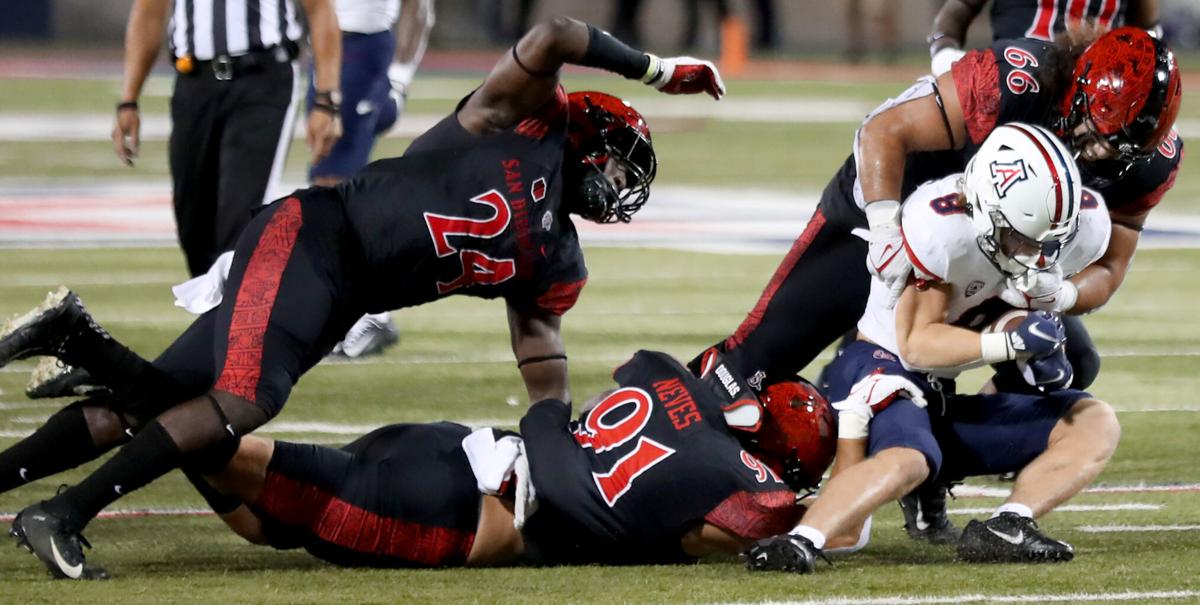The first call vibrated my cell phone 73 minutes before Saturday’s Arizona-San Diego State kickoff.
“Something’s really wrong here,” my friend said. “The line to get in the stadium is taking more than an hour. People are just leaving, going home.”
Six minutes after kickoff, former UA women’s basketball coach Joan Bonvicini posted a video of the chaos outside of Arizona Stadium. “I love Arizona athletics and Arizona football, however, you need to figure out the ticket situation for your team,” she wrote. “There are at least 20,000 people outside the gates trying to get into the game.”
Early Sunday morning, my inbox was choked with messages from unhappy Arizona football fans.
“I am a Arizona football season-ticket holder for many years and I also worked at the UA football games for a long time,” wrote Juan Alvarez. “I have never seen such long lines to get into Arizona Stadium, and this game was not even close to being a sellout. I missed most of the first quarter because I could not get in. The fan experience last night was just as bad or even worse than the football team’s performance.”
A few minutes later I checked the football site at arizonawildcats.com. The game story from San Diego State’s 38-14 victory over Arizona began with the dateline “TUSCON.” (It has since been corrected).
If this isn’t rock bottom, what is? Thousands of fans were not in their seats in time to watch celebrity game captain Steve Kerr participate in the coin flip, which turned out to be the highlight of a 3-hour, 18-minute game.
Arizona’s 14-game losing streak is the longest among all 130 FBS teams. Its listed attendance of 39,097 was the lowest for an Arizona Stadium home opener since 1992.
This isn’t just zero level in a football sense, it’s subterranean. Imagine how much worse it might’ve been if Tucsonans had responded to Jedd Fisch’s constant pleas to “pack the stadium.”
A few minutes before midnight, the UA athletic department responded to complaints with a simple Tweet:
“We appreciate your patience through some extra security measures entering Arizona Stadium. We acknowledge the delays and will work to alleviate them moving forward.”
No, this isn’t Tuscaloosa (or even Tempe).
In retrospect, the pregame calamities at Arizona Stadium were predictable. The available game-day work force is not as large as in previous seasons, as linked to the coronavirus pandemic. For the first time, the school eliminated printed tickets and required digital tickets and electronic scanning. It’s a slower process. It only takes a few tech-challenged customers whose phones stall or who can’t find the correct email to put the entire process on hold.
Security measures were intensified to the point that one emailer told me that a security guard grabbed his binoculars and looked through the lenses to make sure they weren’t filled with liquor.
It has been 277 days since Arizona was eternally humbled by ASU, losing the Territorial Cup 70-7. But on opening night, 2021, everything had changed and nothing had changed.
Does it get any easier? No. It gets more difficult, if that’s possible.
Ticket sales will almost surely set a historic low for Saturday’s game against NAU, drawing the fewest fans at Arizona Stadium since the stadium was expanded in 1976. (The 45-year low is 35,599 set in a 1982 rainstorm against Oregon State.)
There will be no “if I don’t go to the game, I might miss something” appeal.
The only good news is that the game-day work force should improve its effectiveness from Game 1 to Game 2 more than the Wildcat football team did.
As for the UA football team, who knows? Fisch has probably broken an NCAA record for the number of motivational experts who have talked to his team and staff, either in person or virtually, from NFL head coaches to a former surgeon general of the United States. Yet the Wildcats seemed numb against SDSU, although on Tuesday UA defensive coordinator Don Brown denied that.
“Was there a lack of energy? No,” he said.
The next man Fisch would be wise to speak with is Mike Stoops, who captained the most difficult rebuilding job in UA football history. If Stoops kept notes of the 2003 season, it should be required reading.
Stoops inherited a team that had gone 4-20 over three previous Pac-10 seasons. That’s about all he inherited. His quarterback depth chart in ’03 was true freshman Kris Heavner, redshirt freshman Ryan O’Hara and sophomore Nic Costa, the veteran of the group. Costa had thrown seven passes in his college career.
Stoops went 3-8 and 3-8 his first two seasons. He didn’t find a franchise-type quarterback until Willie Tuitama became a starter during the middle of the 2005 season.
No one took mercy on Stoops. Cal beat his first two UA teams by a combined score of 66-0. San Diego State coach Brady Hoke had a similar approach against the Wildcats last week. On Tuesday, Brown emphasized that Hoke “did not take anybody out” even though the game was a rout by halftime.
Add that to the lessons-learned category for the 2021 Wildcats.
Arizona not only has to get better, it has to get tougher. In a best-case scenario, it’ll be two or three years until Fisch can deploy a team with enough talent and depth to avoid getting knocked around its home turf by a mid-level program like San Diego State.
Until then, patience is suggested.





